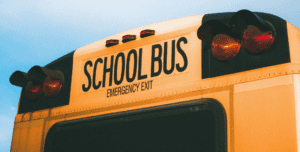Bullying is a serious and frightening concern for children, parents, and school staff alike. The National Center for Educational Statistics reports that one out of every five students report being bullied. Moreover, the Centers for Disease Control report that students who experience bullying are at an increased risk for depression, anxiety, sleep difficulties, lower academic achievement, and dropping out of school. Although we all do the best we can to protect our kids, we cannot always be with them in every setting possible to prevent things like bullying from occurring.
One of the most common places that students experience bullying is on the school bus. Educators and parents rely on school bus drivers to play a crucial role in monitoring student behavior and intervening when necessary. However, we all know that a school bus driver’s attention needs to be on the road at all times for the safety of everyone on and off of the bus. While they do the best they can, it is impossible for bus drivers to thoroughly monitor and manage all student behavior during each commute. A proactive approach to helping our bus drivers provide a safe environment for our children has never been more important.
What really happened?
Imagine a scary, but far from uncommon scenario. A young girl of middle school age works up the courage to come forward and tell school officials that she was inappropriately harassed and touched by a high school junior on the school bus. The junior emphatically denies the allegations. The bus driver didn’t see or hear anything out of the ordinary. The bus has a standard camera in the front, but the footage is too far away and unclear to determine what happened, and there is no audio.
Both sets of parents are unbelievably upset and threatening legal action against each other and the school. There is no way to truly know what happened, and everyone involved is alarmed and confused. School officials are deeply concerned for the students involved and want to do their best to find the truth. What is the right decision to make for the young girl, the accused junior, and both of their families? How does the school prevent the possibility of a situation like this in the future to ensure the safety of their students?
We’ve come a long way from the black boxes
Many of us remember the old black box that was used for monitoring students on the bus back in the day. Many buses today are equipped with cameras. However, these cameras are limited to one viewpoint from the front of the bus, and many lack any sort of sound capturing data or communication capabilities. Furthermore, the current camera technology that is on most buses is out of date and often requires extensive steps to be taken just to view the footage.
As our superintendents, district safety directors and school board members have reported, “Technology on most buses is from the 20th century. It’s time to upgrade.”
Updated bus monitoring systems can serve as a deterrent to inappropriate behavior, promoting a safer and more respectful environment for students and bus drivers alike. The goal of this technology is to promote and provide a safer place for students, and ease of mind for parents. Benefits to this approach include better control over student behavior and well-being for those who are tasked with taking care of our youth.
Bullying and violence can only be stopped when adults respond quickly and consistently to the situation at hand. This new technology is able to do just that by monitoring students in real time and calling out any behaviors that are inappropriate or deemed bullying.
Implementing updated bus monitoring ensures accountability and transparency, builds trust between educators, students, and parents, and creates a more positive and supportive learning environment for our most precious bus cargo, our children.
Are school buses part of your school safety plan?
It’s crucial to include school buses as part of your school safety plan. Here are a few things to keep in mind when incorporating school bus safety into your larger strategy:
- Work with stakeholders to develop failsafe and efficient safety protocols for school buses. Students have a right to a safe ride to and from school. Including the input from transportation staff, school administrators, teachers, and parents ensure clear, actionable guidelines and procedures are in place.
- Identify and respond to aggressive behavior in your immediate response plan. Prevent repeat behavior that leads to bullying incidents on the school bus. The best prevention plan for future bullying is to respond immediately. The best School Safety Plan outlines immediate response when a student reports being bullied.
- Every concerned parent interaction results in the parent experiencing district concern for their student safety, regardless of the outcome. Due process supported by live technology gives timely, reliable results.
- Address bullying on the bus with school administrators, teachers, bus drivers, counselors, and in some cases, local law enforcement. Clear lines of communication, supported with clear audio/video is key to effectively addressing and resolving bullying incidents.
- Assure your district’s compliance with the legal ramifications related to addressing an incident of bullying. Understand the relevant laws and regulations governing student safety and bullying prevention in your state and ensure that your action plan aligns with these policies to protect both the victim and the accused.
We know it’s difficult
Do you have certain buses that cause more trouble than others? We know it’s tough to keep everyone safe every day (while maintaining your sanity). We’re here to help! Share your challenges with us and together we can find solutions to ensure the safety of all students on their way to and from school each day.



